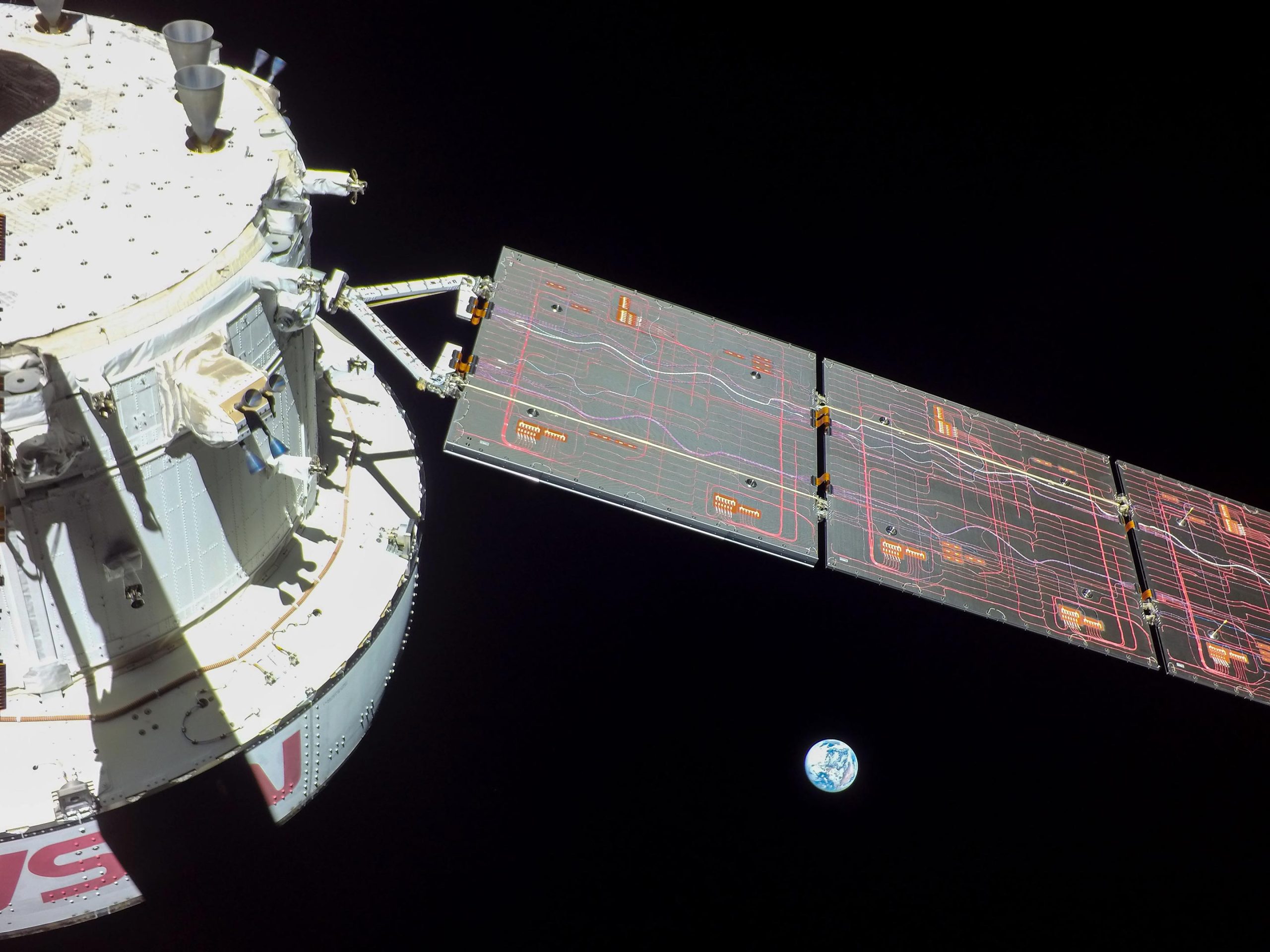
Een zicht op de maan vanuit de European Space Agency (ESA) European Service Module van de European Space Agency die NASA’s Orion-ruimtevaartuig naar de maan en terug bestuurt, op de negende vluchtdag van de Artemis I-missie, op 24 november 2022. NASA
Gisteren om 16:52 CST (23:52 CET, 22:52 GMT) werden de hulpstuwraketten van de European Service Unit afgevuurd om[{” attribute=””>NASA’s Orion spacecraft into a lunar orbit, ten days after liftoff on Earth.
The European Service Module is powering Orion to the Moon and back, providing electricity, propulsion, keeping electronics and the crew module at the right temperature. On the next Artemis missions, it will also provide water and air for astronauts.
Artemis I is an uncrewed mission that is being used to demonstrate and test the Orion spacecraft’s capabilities. It also affords mission control the opportunity to get used to flying Orion and operating the European Service Module.

ESA designed and oversaw the development of Orion’s service module, the part of the spacecraft that supplies air, electricity and propulsion. Much like a train engine pulls passenger carriages and supplies power, the European Service Module will take the Orion capsule to its destination and back. The Orion spacecraft is built by NASA with ESA providing the service module. The arrangement stems from the international partnership for the International Space Station. Credit: ESA–K.Oldenburg
Distant lunar orbit
Yesterday’s firing of the engines has pushed Orion in the opposite direction of travel to our Moon, and occurred relatively far away from the lunar surface, putting the spacecraft into a so-called distant retrograde orbit. This elongated orbit around the Moon uses little fuel. Orion’s mission profile will see it leave halfway before the full twelve-day orbit, firing its thrusters in six days to fly closer to the Moon on a final flyby and then slingshot back to Earth.

Picture of the far side of the Moon taken on flight day six of the Artemis I mission from the Orion spacecraft optical navigation camera. Credit: NASA
ESA’s Philippe Deloo explains “The European Service Module is operating more fuel-efficiently than the Artemis mission designers had foreseen, and it produces more electrical power while consuming less – many things have impressed us on the module’s performance so far.”
Orion spreading its X-wings
The Artemis I mission is an opportunity to push the Orion spacecraft to its limits. Throughout the mission multiple demonstrations are taking place, testing the mission operations teams and allowing them to learn how the new spacecraft is behaving.

View of Earth seen from ESA’s European Service Module that is powering NASA’s Orion spacecraft to the Moon and back, on flight day nine of the Artemis I mission, on November 24, 2022. Credit: NASA
“Mission control is enjoying pushing Orion and the European Service Module to their limits,” continues Philippe, “the years of planning, designing, and building to the highest specifications are paying off, the European Service Module is performing better than we could have ever expected and we have lots of data to analyze and learn from, to ensure we will be taking astronauts to the Moon in the safest and most efficient way possible.”
As the first European Service Module has been earning its wings flying around the Moon, the second module is already almost complete – its solar wings are folded and packed in storage to be attached to the second Orion spacecraft next year. The second Artemis mission will have astronauts aboard and fly a less intensive route around the Moon and back.

The fourth European Service Module structure to power astronauts on NASA’s Orion spacecraft to the Moon is now complete. The structure is seen here at a Thales Alenia Space site in Turin, Italy. Credit: Thales Alenia Space
The third European Service Module – that will take astronauts to a Moon landing – is in production at the Airbus integration hall in Bremen, Germany, alongside the fourth European Service Module that will power the first ESA astronaut and European lunar Gateway element to lunar orbit. The structure for the fifth European Service Module is set to arrive in Bremen next month.

On Flight Day 8, NASA’s Orion spacecraft was two days away from reaching its distant retrograde orbit. The Moon is in view as Orion snaps a selfie using a camera mounted on one of its solar array at 10:57 p.m. EST. Credit: NASA
“The demonstrated flight excellence of the European Service Module and Orion so far, together with ESA’s ambitious plans and newly announced astronauts make for an exciting immediate future for European human spaceflight” concludes Philippe.
The mission is set to end with a splashdown in the Pacific Ocean on December 11.

“Gamedokter. Een zombiefanaat. Muziekstudio. Ninjacafé. Televisieliefhebber. Aardige fanatieke alcoholist.






More Stories
China is van plan het Tiangong-ruimtestation uit te breiden; Stel deze in op “Space Rule” omdat het ISS wordt uitgeschakeld
De Verenigde Staten detecteren het eerste geval van de H5N1-vogelgriep bij een varken, wat aanleiding geeft tot bezorgdheid voor de mens
NASA zal in 2025 de ruimtewandelingen aan boord van het internationale ruimtestation hervatten na een lek in het ruimtepak